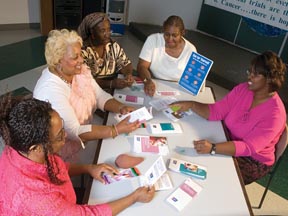The University of Alabama at Birmingham Comprehensive Cancer Center’s Deep South Network for Cancer Control now includes research among its core outreach and awareness activities to reduce cancer disparities in the South’s poorest communities.
|
|
| Deep South Network Program Director Claudia Hardy (right) led a breast and cervical cancer education session. Download image |
Cancer rates in minority and under-served populations in the South are among the nation’s highest. For more than 10 years, the Deep South Network has targeted two poor, rural regions — Alabama’s Black Belt and the Mississippi Delta — and the urban areas in Jefferson County, Ala., and the Hattiesburg/Laurel, Miss., metropolitan area. The network has trained more than 1,000 volunteer Community Health Advisors as Research Partners to educate family and friends about the importance of prevention and early detection of cancer.
This past year, $1.2 million per year was allocated to fund community-based cancer research in these targeted areas from funds provided through National Cancer Institute Center to Reduce Cancer Health Disparities. This new scientific approach mandates a partnership between academically trained scientists and members of the community. “By expanding our efforts from education and awareness to include research, we expand the efforts and scope of our CHARPs and local community partners,” says Claudia Hardy, program director for the network.
With obesity rates at the highest in Southern states and its link to cancer, one of the research projects will examine evidence-based strategies to support weight-loss among African-Americans. Monica Baskin, Ph.D., associate professor of preventive medicine at UAB, will conduct a 20-week weight-loss intervention in eight of the 20 counties within the network that provide peer and community support. CHARPs will recruit participants, provide peer counseling to the weight-loss participants and survey grocery stores and the walking environment to ascertain the availability and cost of fruits, vegetables and other healthy foods and the ‘walkability’ of the communities.
“We’ll be able to create a comprehensive map showing the areas in which more work needs to be done to ensure that residents have healthy food options and an environment conducive to increasing physical activity,” says Hardy.
The first wave of the research will be conducted in Bullock and Wilcox counties in Alabama and Grenada and Yazoo counties in Mississippi. The second wave will be in Perry and Sumter counties in Alabama and Panola and Humphreys counties in Mississippi in Spring 2012.
The remaining 12 Deep South Network counties will continue to use other evidenced-based programs to conduct cancer-awareness activities to improve screening rates in ZIP code-specific communities that have lower screening rates.
“As the only NCI-designated comprehensive cancer center in a five-state region, UAB has an obligation to address the South’s cancer burden,” says Edward Partridge, M.D., director of the UAB Comprehensive Cancer Center. “The work of the Deep South Network is significant because it enables community leaders to partner with our researchers. I am positive that this grassroots effort, with its scientific basis, will bring our cancer rates down.”
The Deep South Network, led by Partridge and Hardy, received its initial funding as a Special Populations Network in 2000. The program was able to receive continued funding in 2005 as a Community Network Program. The current grant comprises four cores: administrative, community outreach, training core and research. Research core co-leaders are Isabel Scarinci, M.D., associate professor of preventive medicine at UAB, and Lucio Miele, director of the Cancer Institute at the University of Mississippi Medical Center.
“By joining forces with the Cancer Institute at the UMMC, the Deep South Network is poised to provide the highest-quality scientific merit to the education and the clinical needs of medically under-served residents of Alabama and Mississippi,” says Hardy.
“This project covers 12 of the poorest Alabama counties and eight counties in Mississippi. We’ve made the commitment to have local people work in all these counties, and the partnership benefits the community from an economic standpoint,” says Hardy. “Seventy percent of the program budget is for staffing. We hope we have made the communities healthier, and we hope we have built the capacity of local individuals to ensure its sustainability.”
